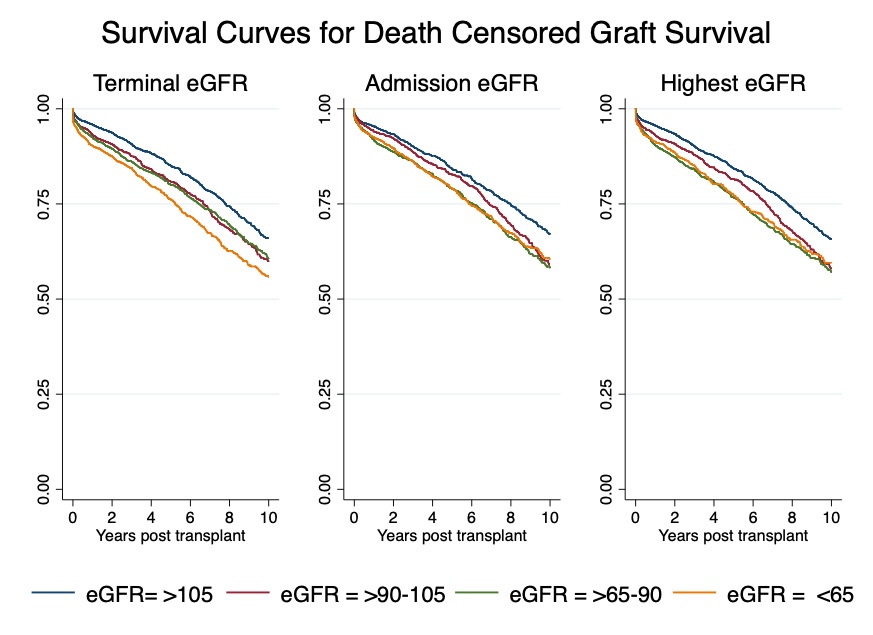Does Donor Terminal, Admission or Best Estimate Glomerular Filtration Rate Predicts Kidney Transplantation Outcomes
1Australia and New Zealand Dialysis and Transplant (ANZDATA) Registry, South Australian Health and Medical Research Institute, Adelaide, Australia, 2Central and Northern Adelaide Renal and Transplantation Services, Royal Adelaide Hospital, Adelaide, Australia
Meeting: 2020 American Transplant Congress
Abstract number: C-012
Keywords: Allocation, Graft survival, Kidney transplantation, Renal function
Session Information
Session Name: Poster Session C: Kidney Deceased Donor Allocation
Session Type: Poster Session
Date: Saturday, May 30, 2020
Session Time: 3:15pm-4:00pm
 Presentation Time: 3:30pm-4:00pm
Presentation Time: 3:30pm-4:00pm
Location: Virtual
*Purpose: When assessing deceased kidney donors, a key factor is donor kidney function. It is unclear whether terminal, admission, or the best of terminal and admission estimated glomerular filtration rate (eGFR) best predicts outcomes. We aimed to examine which eGFR measure most accurately predicts recipient outcomes.
*Methods: Using data from the Australia and New Zealand Organ Donor (ANZOD) and Dialysis and Transplant (ANZDATA) Registries, we included adult recipients of deceased donor kidney-only transplants over 2003-2017. We created multilinear regression models for the outcomes of recipient eGFR at 6 and 12 months. We compared the models using F test and adjusted R squared. We constructed Cox proportional hazards models for the outcomes of graft survival and death censored graft survival.
*Results: 7303 transplant recipients were included in the analysis. There was strong evidence of an association between terminal, admission and best donor eGFR and 6 and 12 month recipient eGFR (figure1). The models performed similarly, although adjusted R squared values were slightly better for terminal eGFR at 6 months and admission eGFR at 12 months. The Cox proportional hazard models showed eGFR was a strong predictor of graft survival, and terminal and best eGFR were better predictors than admission eGFR (figure 2). The C statistics for discrimination were similar across all models (0.65-0.66).
*Conclusions: In deceased kidney donors, admission, terminal and best eGFR are all strongly associated with recipient kidney function. Terminal and best eGFR were slightly better than admission eGFR at predicting graft survival.
| Multilinear regression | Cox Proportional Hazard Model | ||||||
| Outcome | 6 month eGFR | 12 month eGFR | 6 and 12 month eGFR | Death Censored graft survival | |||
| Beta coefficient (SE) | F test statistic p value | Beta coefficient (SE) | F test statistic p value | Adjusted R squared | Hazard Ratio (95% CI) | Wald statistic p value | |
| Terminal eGFR | 0.072 (0.009) | 9.31 P<0.0001 | 0.068 (0.009) | 7.88 p<0.0001 | 0.28 | 0.94 (0.92-0.96) | 20.30 p=0.0004 |
| Admission eGFR | 0.050 (0.010) | 3.85 p=0.0002 | 0.054 (0.011) | 4.59 p<0.0001 | 0.27 | 0.95 (0.92-0.98) | 9.67 p=0.0464 |
| Best eGFR | 0.090 (0.011) | 8.99 p<0.0001 | 0.090 (0.012) | 8.25 p<0.0001 | 0.28 | 0.94 (0.91-0.97) | 16.24 p=0.0027 |
To cite this abstract in AMA style:
Irish G, Coates T, Clayton P. Does Donor Terminal, Admission or Best Estimate Glomerular Filtration Rate Predicts Kidney Transplantation Outcomes [abstract]. Am J Transplant. 2020; 20 (suppl 3). https://atcmeetingabstracts.com/abstract/does-donor-terminal-admission-or-best-estimate-glomerular-filtration-rate-predicts-kidney-transplantation-outcomes/. Accessed January 4, 2026.« Back to 2020 American Transplant Congress

